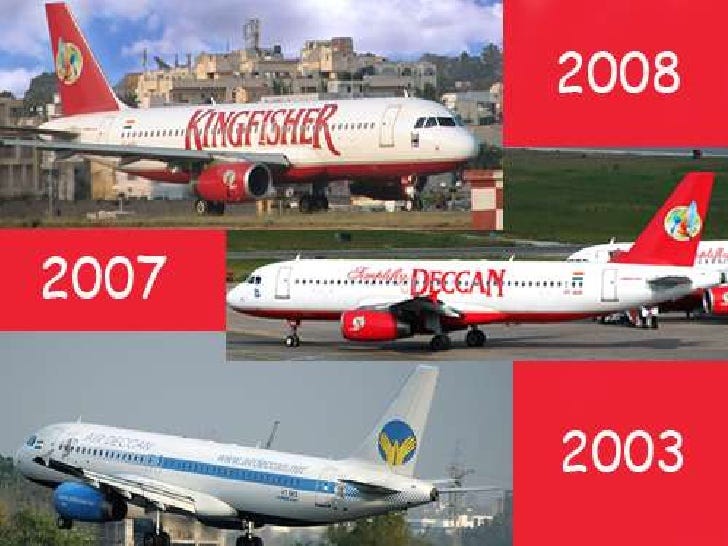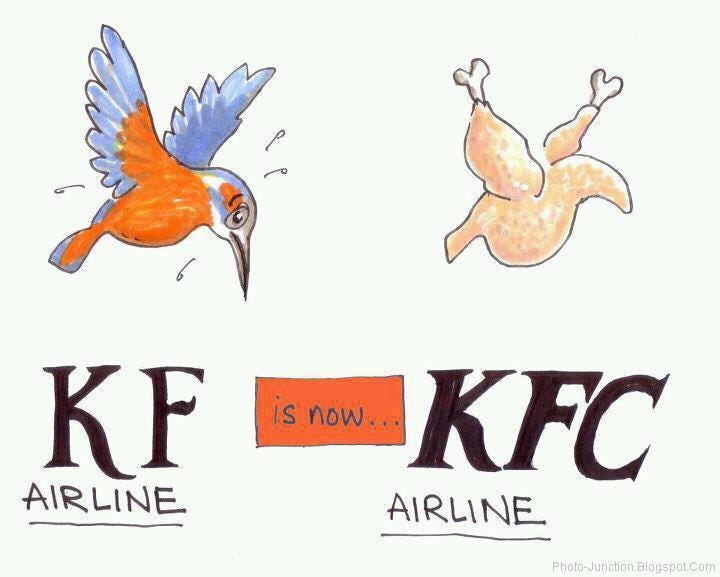Weekly "Sapience"- 4
Kevin's Newsletter #4
Hey fellow readers, this is my fourth sapience (for those who are new, sapience = learning).
But first, let me tell you that I am a big Aviation enthusiast. So as you know I sell small and fun research articles on Gumroad. This month’s article is on Samuel Langley who was considered to be an aviation pioneer and started the work to build an aircraft before the Wright brothers did. I have included memes and illustrations to make it a bit fun to read. The lite version is free now. Do check it out.

1. The fall of Kingfisher Airlines
I’m sure many of you have watched the series “Bad boy billionaires” on Netflix. There are certain details that were left out about Kingfisher’s fall. This small article would help you understand how they collapsed and the main reasons for such sharp downfall.
Did you know Kingfisher had ordered 10 A380’s? YES, 10!!!

Kingfisher was a major airline based in Mumbai, India. It was the fifth Indian airlines that provide the largest passenger airline in which international and domestic flights are provided to the customers with very flexible fares. Kingfisher was one of the largest airlines in India and it was established in 2003. It was owned by the Bengaluru based United Breweries Group. The commercial operations are started on 9 May 2005 with the fleet of four new Airbus A320-200s Operating flight from Mumbai to Delhi.
Kingfisher Airlines as a five-star carrier, with personal in-flight systems, captivating customer support, and exquisite cuisines for the passengers. The launch of Kingfisher happened during the period when the aviation industry in India was in a boom and the launch of several new private airlines between 2004 and 2008 helped the matter more. Jet Airways was good and on time, but was for busy executives; Air Deccan was for the common people, a kind of shuttle service. In time, the airline became a stepping stone for the chase of other adventures like acquiring White and Mackay. After starting its operations Kingfisher Airlines faced stiff competition from the upcoming low-cost carriers and also Mallya was keenly waiting to fulfil his international ambitions as in India, an airline needs to complete five years of domestic services before it can endeavour into international skies.
1st Mistake- Luxurious service at low price

Unlike road or rail transport, where there’s much of scenery around to keep you busy, flights are usually boring. Much of the travel through flights between metros is covered in less than two hours. In-flight entertainment or a movie is started only after the seat-belt signs are off. And then there’s an interruption of meals being served. Most passengers on domestic flights are not looking forward to in-flight entertainment. They want to reach their destination on time. In-flight entertainment can be handy for a weary traveller on international circuits only. I believe this one of the mistakes Mallaya made introducing In-flight entertainment systems in short-haul flights.
2nd Mistake- Merger with Air Deccan

Kingfisher Airlines took over low-cost carrier Air Deccan in 2007. Vijay Mallya linked in and forked out Rs. 550 crores for acquiring 46% stake in Deccan Aviation. Subsequently, in December 2007 the boards of both the airlines decided to merge Kingfisher Airlines and Air Deccan. From a 100% full-service model, Mallya switched to two brand strategy—Kingfisher Airlines and Kingfisher Red (the low cost-service of Kingfisher, after the merger). Kingfisher Airlines got Air Deccan’s huge market share and several aircraft s as well as an immediate listing of the airline. It also availed the license to fly on international routes, as Air Deccan had been in the business for more than five years. Kingfisher Airlines’ merger with distraught budget carrier Air Deccan gave Kingfisher prompt control over 29% of the domestic passenger market to meet arch-rival Jet Airways head-on, as Air Deccan had a domestic market share of 19% and a passenger base of three million by June 2006. By acquiring Air Deccan, Kingfisher Airlines also acquired the losses incurred by Air Deccan, since financially the carrier wasn’t in a sound position. As per Air Deccan Prospectus, prior to the merger, Air Deccan had a loss burden of Rs.725.01 crores for the quarter ending September 2005.
Other low-cost carrier tactics like keeping overhead costs reduced by flying a single-class arrangement of aircraft, quick aircraft turnaround, selling tickets online, selling of food on board were never assimilated into the main operations of Kingfisher Airlines. This also incurred a lot of losses for the airlines in red.
3rd Mistake- Improper pricing

With the ticket fares much more than Indigo, Spicejet, Sahara, people began to become reluctant in choosing Kingfisher as most of the Indian market was very price-conscious. So, the other aggressive airline operators in the low-cost segment such as Indigo and Spicejet persuaded away passengers with attractive fares. Kingfisher’s fleet size also reduced from its highest 85 in December 2008 to 66 in October 2011. In contrast Jet and Indigo had 100 and 64 aircraft s respectively. In September 2011, Kingfisher Airlines changed its business model by withdrawing its Kingfisher Red brand and completely transforming its fleet to a dual-class, full-service conformation. In the aviation industry, the operative costs of Kingfisher were the highest (apart from Air India) in the month of October 2011. Kingfisher was unsuccessful to scale up its transnational operations as intended, even after acquiring the low-cost carrier with the plan of flying globally. The unveiling of Kingfisher’s transnational routes coincided with the global financial meltdown of 2008, impacting air travel harshly over the world and jet fuel prices skyrocketed and touched $ 150.
Thus the airline accumulated losses of about Rs. 6000 crores, recording a loss of Rs. 1027.40 crores in the financial year 2010-11. The Directorate General of Civil Aviation (DGCA) then suspended Kingfisher’s Scheduled Operator’s Permit (SOP) on October 19th, 2012 till further orders after a lockout and its failure to come up with a viable plan of financial and operational revival. Since then there have been no plans for their revival.
Before any trial could take place, Mallya left India on March 2016.

Understandably now, India wants Mallya to face criminal action relating to loans taken out by his defunct Kingfisher Airlines and Indian authorities want to recover about $1.3 billion they say Kingfisher owes. Mallya’s counsel was also unable to state by when legal, extradition proceedings will end in the UK. The Supreme Court asked Mallya’s lawyer to provide clarity on the nature of current proceedings in the UK in the next hearing. The next hearing is scheduled for 2 November 2020.
2. The gates of Hell


There are places on Earth that are a little creepy, places that feel a little haunted and places that are downright hellish. The Darvaza gas crater, nicknamed by locals "The Door to Hell," or "The Gates of Hell," definitely falls into the latter category—and its sinister burning flames are just the half of it. Located in the Karakum Desert of central Turkmenistan (a little over 150 miles from the country's capital) the pit attracts hundreds of tourists each year. It also attracts nearby desert wildlife—reportedly, from time to time local spiders are seen plunging into the pit by the thousands, lured to their deaths by the glowing flames.

In 1971, when the republic was still part of the Soviet Union, a group of Soviet geologists went to the Karakum in search of oil fields. They found what they thought to be a substantial oil field and began drilling. Unfortunately for the scientists, they were drilling on top of a cavernous pocket of natural gas which couldn't support the weight of their equipment. The site collapsed, taking their equipment along with it—and the event triggered the crumbly sedimentary rock of the desert to collapse in other places too, creating a domino effect that resulted in several open craters by the time all was said and done. The largest of these craters measures about 230-feet across and 65-feet deep. Reportedly, no one was injured in the collapse, but the scientists soon had another problem on their hands: the natural gas escaping from the crater. Natural gas is composed mostly of methane, which, though not toxic, does displace oxygen, making it difficult to breathe.
This wasn't so much an issue for the scientists, but for the animals that call the Karakum Desert home—shortly after the collapse, animals roaming the area began to die. The escaping methane also posed dangers due to its flammability—there needs to be just 5 % methane in the air for an explosion to potentially take place. So the scientists decided to light the crater on fire, hoping that all the dangerous natural gas would burn away in a few weeks' time. It's not as outlandish as it sounds—in oil and natural gas drilling operations, this happens all the time to natural gas that can't be captured. Unlike oil, which can be stored in tanks indefinitely after drilling, natural gas needs to be immediately processed—if there's an excess of natural gas that can't be piped to a processing facility, drillers often burn the natural gas to get rid of it. It's a process called "flaring," and it wastes almost a million dollars of worth of natural gas each day in North Dakota alone.

But unlike drillers in North Dakota or elsewhere, the scientists in Turkmenistan weren't dealing with a measured amount of natural gas—scientists still don't know just how much natural gas is feeding the burning crater—so what was supposed to be a few-week burn has turned into almost a half-century-long desert bonfire.
Want to visit?
To visit the Darvaza gas crater, it's best to go at night when the fire can be seen from miles away. The crater is located about 161 miles (about a 4-hour drive) from the Turkmen capital Ashgabat. Tours can be booked through agents in Ashgabat. Alternatively, some companies offer more structured tours of the surrounding area, with the Darvaza crater included.
Fact of the week-
Pluto is just marginally bigger than Russia

Surface Area-
Russia- 17,125,191 square kilometers.
Pluto- 17,646,012 square kilometers
Thank you for reading this edition of Sapience. Please share and subscribe if you liked the content and stay tuned for our next “Sapience”. ☺️
If you have any suggestions or queries you can contact me via-
Twitter - @mysapiences
Instagram- @sapience.io
Email- kevin@mysapiences.co.in or
If you have a sapience suggestion please mention it in the comment and I’d definitely do a sapience on that topic next week.
Till next time, Ciao!


